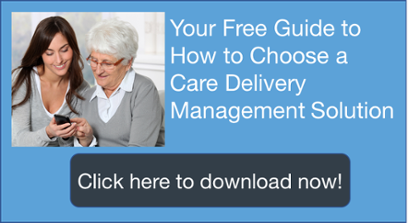10 Ways to Help Home Health Caregivers Feel Connected as an Agency Team
One of the biggest strengths of the home care industry is also one of its biggest challenges: mobile caregivers.
With work that requires them to be out in the field daily, agency caregivers may seldom come into the office or directly interact with their colleagues. As a result, they risk feeling isolated from coworkers and may not understand the valuable contributions they make for the greater organization.
To counteract this, home care agencies often seek to build a strong foundation of teamwork for their field workforce. And yet, creating close-knit, cohesive teams is often harder than it looks.
It helps to first take a step back and consider what actually motivates your caregivers.
Understanding Employee Motivation
There are two main ways a worker is motivated on the job:
- Intrinsic motivation comes from a worker’s own goals and ambitions. For example, the sense of knowing they are making a difference in the lives of others may be enough of a reward for a worker to feel innately satisfied on the job.
- Extrinsic motivation comes from external sources. For example, certificates or prizes can help instill a sense of value and achievement for a worker.
Both types of motivation have advantages and disadvantages. Workers who are intrinsically motivated often need little push from management to excel at their jobs. However, not every worker will find the same meaning in the same tasks, which can be difficult for management to decipher. Relying too heavily on intrinsic motivation can subsequently lead to varying levels of productivity and results.
On the other hand, extrinsic motivation can be a powerful “carrot” that pushes a worker to improve his or her performance, and it allows workers to set clear and measurable goals. However, depending on the specific reward, extrinsic motivation can be expensive to sustain.
The best strategy for home care agencies, therefore, is to strive for a balance of intrinsic and extrinsic motivation techniques. Look for opportunities to showcase the contributions field workers make, not only to the agency’s clients but to the agency itself, to drive a sense of value and self-esteem among employees. Meanwhile, leverage external means to reward employees who demonstrate outstanding performance.
Below, we’ve outlined ten approaches home care agencies can use to help ensure their mobile caregivers feel connected with their coworkers and the business as a whole. Look to implement several techniques, and strive for a comprehensive worker engagement strategy that touches on both intrinsic and extrinsic motivation for the biggest results.
Tips for Keeping Home Health Caregivers Focused and Engaged
1. Involve care staff in decision-making
When you propose changes to policies and procedures that will directly impact your caregivers, stop and listen. What feedback do they have? Give employees a voice in how policies are implemented. In doing so, they may feel more invested in and committed to a desire to truly improve the agency. Plus, they may surprise you with fantastic suggestions.
2. Buddy up
Pair employees who do similar jobs and have them connect regularly. Whether it’s by phone, video chat or instant messaging, routine communication with others who are doing the same job can build lasting friendships while potentially inspiring fresh ideas and new solutions to old challenges.
3. Play a game
Gamify your teamwork with fun activities. For example, give a pedometer (like a Fitbit or Vivofit) to each team member whose numbers can be uploaded or entered into a common document. Create teams based on function or location — or let competitors go solo — and see who takes the most steps in a week or walks the farthest. Winners might receive a small gift card or bragging rights for the week.
4. Schedule one-on-ones
Time is valuable; so is information. Take the opportunity to routinely connect with each team member, asking questions like: What’s going well? What obstacles are you facing? How can I better support you? What are your goals for the month? Asking the same questions each month lets you see evolving trends and progress.
5. Create a recognition program
Offer virtual badges for achievements (for example, badges for 100, 500 and 1,000 clients visited). Accomplishments can be broadcast internally across the company or privately within a team. You can also reward with tangible items, like a gift card to a coffee shop, something related to a worker’s hobby, or even a favorite local treat. When hard work is recognized and appreciated, it’s likely to be repeated.
6. Start meetings with an ice breaker
Because many mobile coworkers might not know each other personally, take time at the start of each meeting to have participants share “coffee break” stories — for example, what they did over the weekend, recent travels, or exciting accomplishments.
7. Engage in praise
Everyone appreciates being recognized for accomplishments. Make this praise a regular part of your agency’s internal communication strategy. Whether it’s a “Caregiver of the Month” certificate or a shout-out on social media, look for opportunities to publicly acknowledge the hard work your employees put in.
8. Collaborate to set goals
Does your organization or team have monthly, quarterly, or annual goals? Include your team in the process of determining what the right goals should be. After all, they are the ones in the field, and they may be experiencing challenges that management doesn’t realize, which could impact their ability to succeed. Or, this could be the motivation they need to push themselves to reach more aggressive targets.
9. Conduct routine conference calls
Scheduled communication – whether weekly, biweekly, or monthly – keeps teams in touch and helps members stay current about what’s going on in the agency and in the field. Empower team members to share their accomplishments and challenges. This will also give you a unique perspective on your staff’s daily activities.
10. Swap a teleconference for a video call
Connecting by video, rather than telephone, puts faces to the names of caregivers who work remotely and may have never met in person. Beyond the practical purpose of encouraging work-related discussions, videoconferences can help remind employees they’re on a team and help them feel more connected with each other.
Ultimately, building connections with team members is vital to employee satisfaction – particularly when these employees have few routine opportunities for face-to-face interactions with other team members. By assuring team members that they’re a vital part of the company, you will boost morale, learn more about your employees, and improve your collective ability to drive sustainable improvements in your organization.
Clear, effective communication in any health care environment is key. With the right technology, this becomes easier than ever.
Contact CellTrak today to see how our mobile care delivery solution can improve the communication between your caregivers and your agency and create a dedicated team that provides exceptional care.


